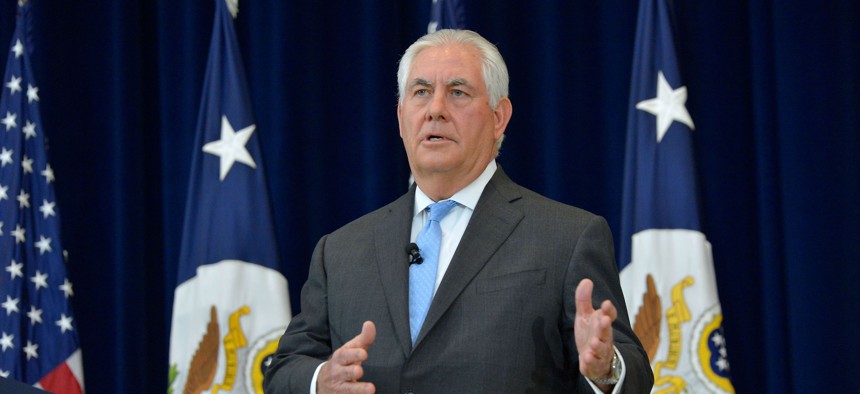
U.S. Secretary of State Rex Tillerson hosts a Town Hall meeting for Department of State employees in Washington, D.C, on December 12, 2017. U.S. State Department
State Dept. IG: Hiring Freeze Hurt Border Security, Counterterrorism, and Other Priorities
Imposed by Rex Tillerson soon after Trump took office, the 16-month freeze crushed morale and hindered operations, the inspector general found.
The State Department’s 16-month hiring freeze, instituted at the start of the Trump administration, hurt activities across the department’s vast operational landscape, according to its internal watchdog, and the nation's diplomats and support staff are still struggling to recover.
The freeze hit State’s civil service much more acutely than its Foreign Service, the department’s inspector general found, with the civil service experiencing a 7% staffing reduction. Due to staffing caps that remained in effect after the freeze ended, State’s civil service has continued to shrink by 2% even after hiring resumed and its bureaus and outposts rushed to backfill positions. The Foreign Service saw a 1% cut and has since recovered its employees.
The hiring moratorium proved devastating for employee morale, the IG said, creating an atmosphere in which employees felt overworked and undervalued. The freeze was not guided by any strategic goals, nor was it connected to the department’s organizational reform efforts. Senior department officials told the IG they “lacked an understanding of any long-term strategic goals the hiring freeze was intended to support and were unable to apply staffing reductions in a way that reflected the department’s strategic priorities.” The lack of new staffing undermined key administration priorities, the IG said, such as counterrorism and border security.
President Trump instituted a governmentwide hiring freeze shortly after taking office. While the White House lifted the broad freeze in April 2017, State kept its moratorium in place through May 15, 2018. Then-Secretary Rex Tillerson had planned to slash State’s workforce by 8%, not including the 50,000 overseas employees. State targeted about 2,000 positions for elimination, 71% of which were civil service jobs.
Related: White House Pauses Some Diplomatic Spending
Related: Staffing Shortages Impede State Department Monitoring of War-Zone Contracts
Related: The Shutdown and the Damage Done
Every bureau told the IG the hiring freeze hurt morale, as did 97% of consulates and embassies. Remaining staff reported high rates of burnout and fatigue. Virtually every bureau and outpost also said the freeze hurt operations. Some senior leaders said they could only take on new initiatives at the expense of existing ones, while others faced an inability to refocus resources on new needs like the crisis in Venezuela.
“Employees felt both overburdened and stuck in their careers, as there was no mechanism for lateral movement or promotion,” one bureau told the IG. “The hiring freeze conveyed a message from department top leadership that our work and mission, and the talents and well-being of our employees, were not valued.”
Diplomatic security for State employees suffered, the IG said, including staffing at a command center dropping below the levels necessary to respond to overseas security crises. The Bureau of Medical Services saw staffing dip by 10%, which hurt support for special needs children of overseas employees, screening of employee mental health issues and oversight of medical personnel. State faced delays in issuing contracts, which subsequently saw less oversight and review. Embassies struggled to oversee counternarcotics and transnational crime programs, while efforts to remove landmines and counter ISIS in Iraq and Syria were hindered. Efforts to reform the security clearance process and switch to cloud computing also suffered, the IG said.
The auditors summarized the freeze’s impact by noting it particularly hurt department’s ability to address its “most significant management challenges.”
Through August 2017, Tillerson personally approved each hiring freeze exemption, before he eventually began doing so in batches. The department approved nearly 5,000 exemptions over the course of the freeze. The implementation of the freeze changed continuously over the 16 months it was in effect, the IG said, which made it more challenging for State bureaus and outposts. Communication was limited, the IG said, and further hampered by the “unusual demands” placed on the department’s human resources office that was simultaneously enforcing the freeze and subject to it. The exemption process was confusing and time-consuming, with posts reporting it took up to nine months and repeated requests to get their hiring approved.
The department is still reeling from the freeze, the auditors found. State officials said they do not expect to recover from the staffing impacts of the moratorium until 2021. Staffing cuts that occurred during the freeze continue to impede State’s ability to fill vacancies, the IG said, and ongoing staffing caps mean it will not fully recover to pre-freeze levels. Jobs for “eligible family members” of government personnel stationed overseas were particularly hard hit, falling by 21% during the freeze. Those jobs are critical for morale and career development of overseas staff across government, the IG said, and cuts require additional Foreign Service staff. Eligible family member staffing still lags 12% behind pre-freeze levels.
While the IG said it could not calculate the total costs of the hiring freeze, it was not clear it saved the department any money. Personnel costs actually grew by $53 million from 2016 to 2017. The department said the freeze reduced growth, but the IG said it also resulted in additional overtime and travel costs and could have increased other financial and contracting costs.
The State Department did not respond to requests for comment.
NEXT STORY: White House Pauses Some Diplomatic Spending
